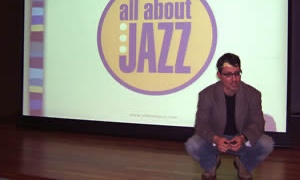Home » Jazz Articles » AAJ PRO » Jazz Ear Training: The Best Ear Training Guide For Jazz Musicians
Jazz Ear Training: The Best Ear Training Guide For Jazz Musicians

Introduction To Jazz Ear Training
Ear training, why should I even bother? There are tons of ear training apps and exercises that can make ear training look far removed from actually making music. But really, you've been training your ears most of your life without even knowing it. We've learned to recognise if melody goes up or down, whether a chord sounds happy or sad, or if a tune sounds 'jumpy' or 'solemn.' We can stomp along to 'We will rock you' or sing back the melody of a tune we've just heard on the radio. Jazz Improvisation is about taking these skills to the next level. When you do so, you can do things like play a melody you've just imagined on your instrument. You can hear a chord progression and understand the underlying musical logic. You can hear a band mate play something and respond with a musically meaningful answer. In short, ear training allows for intuitive and interactive music making, which is both really fun to engage in an incredibly rewarding to learn.How To Start Training Your Ears As A Jazz Musician
The foundation of a trained pair of ears is the same for musicians in any style. I like to define three core ear training skills.Your ability to perceive music in detail. You're already pretty good at this. After all, you've already listened to tens of thousands of hours of music throughout your life. Trained musicians can hear music in greater and greater detail. For example, they can separate out all the instruments and hear exactly what each is playing.
Your ability to hear music, either in your head or 'in real life,' and to reproduce it on your instrument or using your voice. In other words: to play by ear.
Your ability to recognize certain sounds and to apply the correct music theory term. For example, you might hear a melody and recognize that it uses the Dorian scale. Or you might hear a bunch of chords and hear that it's a I-IV-V progression.
I've written more about these core ear training skills in this in-depth guide to guitar ear training, so I won't go into too much detail here. The main takeaway: learning music by ear is an incredible way to train your ears. It's how all the greats did it. Jazz in particular has an oral/aural tradition that doesn't rely on notated music, but on well-trained ears to pass on music to future generations. Moreover, jazz is all about making music in the moment. It's about listening to each other and responding with musically meaningful ideas. To do so, you need to develop your hearing to the point where you truly feel you can play the ideas that come up in your head intuitively, quickly and accurately.
In short, jazz musicians should always keep training their ears. If you're able to hear more, you're able to play more. That's what jazz ear training is all about. It allows you to to musically and playfully use more advanced concepts such as substitutions or upper structures. It allows you to figure out and really hear what Coltrane or Herbie Hancock are doing and incorporate that into your own playing. Theory alone is not enough to do this. You really need to 'hear' what the theory sounds like in the real world, or it will never feel musical or natural to use.
The three skills outlined above are the foundation for ear training in any genre. In the rest of this article, we'll explore how all of this applies specifically to playing jazz. We'll go beyond the standard ear training exercises, and look into hands-on ways that you can practice as a jazz musician.
Quick disclaimer: I'll assume you have some knowledge of music theory for certain sections and are familiar with intervals, chord names and Roman numeral analysis for chord progressions. Wherever possible, I'll keep the theory to a minimum though.
How to Start Jazz Improvisation Using Your Ears
There are many ways of entering the world of Jazz Improvisation. Each has its advantages and disadvantages, but mixing it up keeps it fresh and fun. You can start off by just listening to some recordings you like and play along by ear. At first, it may seem a bit 'random,' but as your ear improves you notice that you're picking up a lot of information. After the recording is done you can review and ask yourself questions like:- What key was the tune in?
- Can I play the melody now?
- What's the chord progression?
- What modulations are there?
Another way to improvise is to play 'from the melody.' The melody of a song contains a lot of information. It has a 'shape,' it has rhythmical information (including when not to play), it lands on specific notes, etc. Give yourself the challenge of 'landing' on the same note as the melody, or of using the same 'shape' or any other parameter the melody gives you. In addition to making your improvisation less random, this forces elements you haven't used before 'into your hearing.'
Obviously it's important to learn from the musicians you like. So spend a lot of time emulating your heroes. Figure out solos and play them both with and without the recording. This is a very natural way of sharpening your hearing and expanding your musical vocabulary. If you find a phrase you like, see if you can incorporate it into your playing. At first, force yourself to play the whole phrase in your improvisation. Next, cut the phrase up in smaller chunks and play around with them. This gives you the freedom to mix up your vocabulary instead of playing the same literal phrase you started with.
Advanced Ear Training For Jazz Musician
Taking things a step further, it's a good idea to start training your ability to hear and reproduce (i.e. sing or hum) different components of a Jazz Standard. This familiarizes our ears to an environment where a lot of (jazz) improvisation takes place. We could say the 'skeleton' of most standards consists of the melody, bass notes, and the guide-tones, which suggest harmony. As an example, we'll use 'Autumn Leaves,' a song any jazz musician should know, but of course, you can do this with any tune you like.First, we can sing the melody of Autumn Leaves. You may think: 'ok, I've just sung the melody, how does this help?' But the melody gives us critical information about the form (which follows the melody) and the important scale degrees. Playing Autumn Leaves, we notice that every phrase ends on the 3rd of the chord it lands on (in the key of G minor: an Eb on Cm7, D on Bbmaj7, etc.). This is useful to notice. It gives you a sense of how thirds sound, which can help you reproduce them later on. It also makes it easier to play songs in different keys, because you now understand the underlying harmonic logic of the tune, instead of just memorising the notes. For example, if you know that the first phrase ends on the 3rd of the 'iv' chord, you can do that in any key.
Next, sing the bass notes. Maybe you need to play them first to get them into your ears, but be sure you can reproduce them by singing. 'Autumn leaves' has a lot of cliché cadences, if you can reproduce and recognise those bass lines, other standards will quickly become easier to learn.
Now it's time to sing guide-tones. The main harmonic information of a chord is in its thirds and sevenths. These notes determine what chord type we're dealing with, e.g. minor seventh, major seventh, dominant, etc. So to get a chord progression in your ears, try singing one note per chord, either the 3rd or the 7th, and connecting that note to the 3rd or seventh of the next chord. Taking the first eight bars of Autumn Leaves, we have two options. One of them is Bb (7th of Cm7), A (3rd of F7), A (7th of Bbmaj7), G (3rd of Ebmaj7), G (7th of Am7b5), F# (3rd of D7), F (7th of Gm7), E (6th of Gm7, the I chord is often played with a 6th, which sounds more stable). Can you do the same starting from Eb (3rd of Cm7)?
Tips For Hearing Chord Extensions
Now that we've discussed the harmonic skeleton of a standard, let's add some colour by looking at chord extensions. A simple way to practice this is to play a chord and see if you can sing the extensions you want. But if you really want to 'build up' the extensions in your hearing, you can try to take a deep dive. Here's how. One way to understand what a chord is is to view it as 'stacking thirds.' We take a root note, then add a note that's a third higher, then add a note that's another third higher, and so on. For example, for a C chord in the key of C we would find out what notes are in the triad like this:C(1)-D(2)-E(3)-F(4)-G(5)-A(6)-etc
So we have a root, a major third and a fifth, which gives us a C major chord. You see that if you do the same starting on D, you will get a D minor triad. Creating a seventh chord works exactly the same way, as does a ninth, or an eleventh or thirteenth chord:
C(1)-D(2)-E(3)-F(4)-G(5)-A(6)-B(7)-C(8)-D(9)-E(10)-F(11)-G(12)-A(13)-B(14)-C(15)-etc..
Can you figure out why there are no 15th chords?
One way of ingraining the extensions into your hearing is to sing stacked thirds in any scale and starting from any note in that scale. As you can imagine, doing the same thing starting on the second note in for example a Mixolydian flat 9 scale gives you very different extensions than in a simple major scale starting from the tonic.Another way of getting extensions in your ears (and to give yourself musical ideas) is to stack triads. For example, let's say you're playing a C major chord on your instrument and sing a B minor triad. You'd play a C(root), E(3rd), G(5th) on your instrument, and you'd be singing a B(7th), D(9th) and an F#(#11th). This gets you a Cmaj9#11. You can try any combination of triads to see which extensions that get you. Try using the ones you like in your improvisations!
Ear Training For Jazz Guitar
Since I'm a guitarist myself, let's talk a bit about ear training for guitar. Many of the principles here apply to other instruments such as piano as well though. For most of this article, we focused on getting certain musical elements 'into your ears.' For example, you might hear a minor major seventh chord and immediately recognize that sound. Of course, another crucial step is to be able to reproduce that sound as well. Your hands need to know what to do to get that sound out of your instrument.Now, this skill is often approached with a lot of theory. People learn scales, arpeggios and chord shapes, which are of course important. But what often gets overlooked is your intuitive sense of how the fretboard works. Every player has this. For example, you know that when you go higher up the neck, you'll be playing higher notes. When you've trained your ear well and are good at playing by ear, this intuitive sense is really dialed in and precise. Without really thinking about it too much, you simply know what your fingers need to do, similar to when you're typing on your laptop. You no longer think about how your fingers need to move for each individual keystroke. You're just typing.
Here are some exercises that can help you develop this intuition.
- I mentioned learning songs by ear. Once you get reasonably comfortable with this, you can start to practice doing this on the fly. For example, just put on a playlist and try to play along with the melody as quickly as possible. Don't overthink it. Just let your fingers do what they need to do. Once you get the melody, see if you can play it in different positions on the fretboard, or if you can play it using only one or two strings. Once you manage, skip to the next track and do the same thing.
- Free improvisation is an incredible way to learn to play by ear. Because nothing has been written out or agreed upon beforehand, you're forced to rely on your ears. Doing this regularly will affect all your playing. More and more you'll know that you can always fall back on your ears and play something that makes sense at the moment.
- Close your eyes, grab your right wrist with your left hand and imagine how you would play certain exercises, melodies or other musical ideas. What would that look like on the fretboard? And what would it sound like?
Ear Training Tools
Finally, let's talk about some ear training tools that can help you on your jazz ear training journey that are especially useful if you're a jazz musician..- Jamey Aebersold's jazz books come with some really great backing tracks. These tracks were recorded by excellent jazz musicians and are well worth checking out.
- The iReal Pro app by Massimo Biolcati Massimo Biolcati makes it easy to play along to a range of jazz standards. The cool thing is you change the tempo, the chords, the style and the instruments playing to suit your practising needs. For example, I like to replace the piano, which can sound a bit 'artificial,' with a Rhodes. Be aware that both this app and backing tracks are not the same thing as organic and interactive music-making with fellow musicians. They're tools for practising.
- If you want to do singing exercises in time, a metronome is perfect. I'd also recommend checking out the app Drumgenius, which features a wide range of great-sounding jazz drum tracks.
- A huge help in figuring out music by ear is the app Transcribe!. Developed by a jazz musician, this app has everything to make it easier to learn music by ear. You can loop sections, slow them down, place markers in the track and much more.
Final Advice for Jazz Ear Training
I know that ear training can sometimes seem a little daunting. Especially when you watch seasoned professionals improvise an amazing solo, seemingly as if it's the most natural thing in the world, you might think: I'm not cut out for this. But of course, what we never see are the hours and hours of practice that went into making it look that easy! Paradoxically, all the hard practice makes the performance look effortless. In short: keep at it. Trained ears exist on a scale, and you can spend a lifetime improving them. So be sure to celebrate the many small wins along the way, as you get better and better. Keep going, and you'll see that ear training and becoming a better musician is an incredibly fun and rewarding journey.Tags
AAJ PRO
AAJ Staff
Jazz Ear Training
Jazz improvisation
Advanced Ear Training
Hearing Chord Extensions
jazz guitar
PREVIOUS / NEXT
Support All About Jazz
 All About Jazz has been a pillar of jazz since 1995, championing it as an art form and, more importantly, supporting the musicians who make it. Our enduring commitment has made "AAJ" one of the most culturally important websites of its kind, read by hundreds of thousands of fans, musicians and industry figures every month.
All About Jazz has been a pillar of jazz since 1995, championing it as an art form and, more importantly, supporting the musicians who make it. Our enduring commitment has made "AAJ" one of the most culturally important websites of its kind, read by hundreds of thousands of fans, musicians and industry figures every month.




















